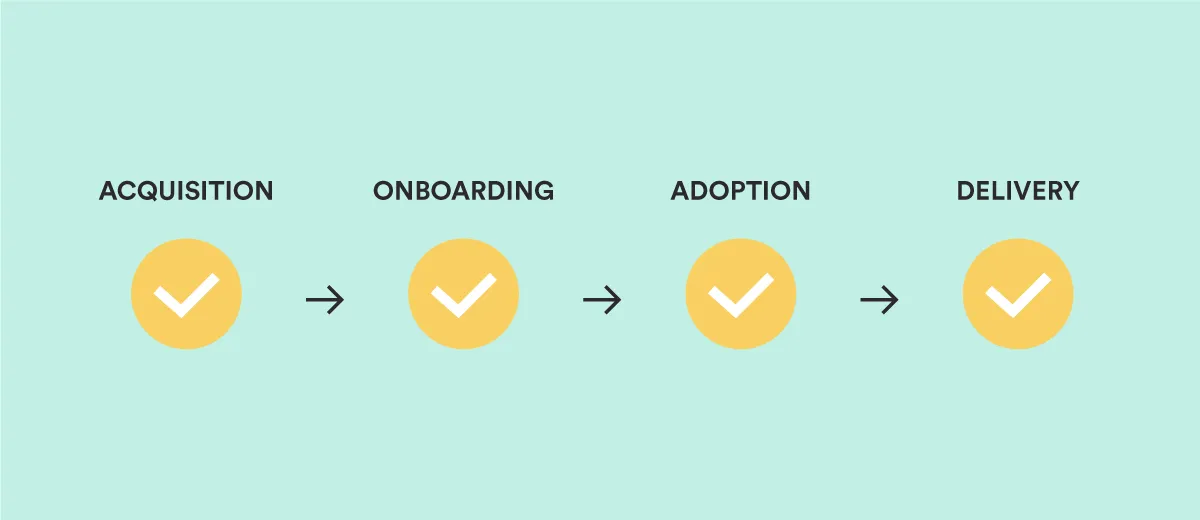Craft a Strategic Success Plan for Your Customers

Housing contractors have one. New students have one. Politicians have many. What am I referring to? I am talking about a plan.
Customer success managers are no different. They need to have a solid idea of what they want to deliver to the customer and how it will be delivered.
If you are working in customer success or if you work directly with customers in general, you know that you can’t support them in a proper manner without a proper plan.
But before you get started on drafting your plan, you need to get a few things in order.
Let’s talk about what you need and who is involved in creating the best customer success plan possible.
Table of Contents
Preplanning: Your Success Plan is Not What You Think
Imagine you’re planning a trip to visit the Monteverde Cloud Forest in Costa Rica and a day later, you’re suddenly dropped off right in the middle of the jungle. You might have heard from a colleague about the vast biodiversity of the forest and the wild animals. Perhaps you also did some research beforehand so you had a decent idea of what to expect.
But when you finally arrive and experience everything all at once for the first time, it’s a whole different world and it can get pretty confusing!
But … luckily for you, you are actually the tour guide! You know what to expect from the jungle and you have crafted a detailed map for navigating through every square mile of the wilderness. Not only that, but you have crafted a plan to help anyone who enters the rainforest so that they have the best possible experience during their adventure and don’t get lost!
This little analogy is similar to how new customers feel when they are thrown into the new product – and you, as the customer success manager, are kind of like their tour guide.
Your customers have signed up for your new solution and while you are consumed with your customer success metrics and goals, your new customer is probably a little nervous about things. How do they use your product effectively? How can they reach their goals? Will the product work for them as they originally expected it to?
Ironically enough, planning out your customer success plan is just as important as the plan itself.
But before we get into it, there are two very important (and often overlooked) points you must always keep in mind:
- Your customers are essentially the one guiding the creation of your plan.
- The creation of the customer success plan is NOT the sole responsibility of the customer success team. All those who have a close relationship with the customer should be included, such as sales, product, and, naturally, the customer.
Below, I’ll discuss exactly what you need to create an effective customer success plan that will allay all your customers’ fears and bring them to success in no time!

Why Do You Actually Need a Success Plan?
Why do you need a customer success plan for your customers? Well, why does anyone need a plan at all?
Well, first, let’s look at the definition of a customer success plan. A quick Google search returned a really good definition:
“A customer success plan is clear statement of “what” and “how” you will deliver value throughout the customer lifecycle. The customer success plan is built by understanding expectations—both your customer’s and your own.”
Now, if we break this definition down, you’ll notice key words such as “value” and “understanding expectations”.
In the SaaS business, the importance of value creation for the customer can’t be emphasized enough.
Think about it: Why would you actually invest money in something that doesn’t add value to your life or business in some way? Whatever you buy has to serve a purpose, and as a customer success manager, it’s your duty to ensure that your customers get the most value out of your solution – and we don’t necessarily mean value for money. It’s about focusing on how your product exceeds your customers’ expectations and how you can help them see and realize that value.
The subscription-based pricing model supports this kind of value-focused mindset. The subscriber remains at the center of the business strategy and it isn’t just the product anymore that determines if they decide to stay with the service or not. It’s about the experiences, the services, the emotional connection to the brand, and of course, the pricing.
Regarding the “understanding expectations”, this is a two-way street. As a CSM, you have the responsibility to define what your expectations are (as well as the company’s) from the business relationship as well as understand what your customers’ expectations are – and then align these.
From here, you will begin to facilitate an effective product adoption rate, prevent your customers from churning, and, ultimately, create customer and product advocates.
This is where your customer success plan will help you align expectations and goals, which will ultimately help you overcome potential roadblocks and help you grow the business and map out your expansion strategy. And bonus: With a customer success plan, you provide more company-wide transparency on customer health, which will bring you closer to your ultimate goal of becoming a customer-first company!

5 Simple Steps to Creating Your Customer Success Plan
So, Where Do You Start?
Unfortunately, many SaaS companies start by not doing anything at all. They claim that they neither have the time nor resources to create a customer success plan, but in the long-run, this is counterintuitive. You’ll essentially be conducting your operations blindly, and in the end, this is what will cost you time and money.
Don’t fall into this trap! Read on to see why your success plan is key to recognizing and ensuring customer success.
Step 1: Define Expectations
This is a pretty logical first step. You simply can’t plan anything if you don’t know what your end-goal and milestones are. What’s important at the very beginning of your plan is to find out WHY your customers have signed up for your product. What are their motivations for doing so? What are their pain points? What do they actually want to achieve? And what does success mean for them?
Once you’ve established what each customer wants and expects, you can start creating your user personas and segmenting your customers. This will help you tailor each plan to meet the needs of each grouping. This is crucial because in the B2B market, not all customers are the same, and if you can’t meet their individual needs, well, they’re likely to churn.
Never assume that you know what your customers’ expectations are – this is a rookie mistake! Don’t be afraid to let them (along with other stakeholders) tell you. Even if they aren’t sure, this means that you can define expectations together!
Once you’ve defined expectations/ goals and segmented your customers, you’ll need to prioritize and then address each one as you go along and work with your customer.
Step 2: Go from Expectations to Action
Now you’ll need to figure out what processes to put in place to ensure that you are meeting (and hopefully exceeding!) your customers’ expectations. For example, your customers want to onboard and figure out how to use your solution as quickly as possible. Your process, then, would be to walk with your customers as they onboard, guiding them as they go along (be this with onboarding emails, documentation, or using a customer onboarding platform like Userlane!).
Step 3: Measuring the Deliverables (Based on the Goals)
In general, customer goals and expectations can vary, but they mainly reflect back to their goal of improving their own business.
It’s also important to note that each expectation is tied to its own metric that you can track and measure.
This will ultimately help you monitor your customer health and identify any red flags that you can address before you have to put out fires – which should never be the case!
Also, always keep in mind that for every customer expectation, there is a person who is responsible for that expectation. For example, if your customer expects optimal value from your product, then assign someone to measure whether the customer is actually getting the best value from your product by having, for example, Quarterly Business Reviews and tracking ROI.
It’s important that your objectives are measurable and actionable. For example, maybe your company objective is to maximize customer value to achieve negative churn. So, how would you go about doing this in a measurable and actionable way? It could be something like ensuring that 50% of customers who renew in the next six months have an agreed upon and well-discussed success plan!
Step 4: Let’s Talk Strategy and Tactics
It’s now time to actually help your customer draw up the plan so that they can start measuring and tracking their success and results.
Creating the plan doesn’t need to be complicated. If you see our example above, it can easily be documented in a spreadsheet and shared with the customer.
Once you’ve created the plan, it’s now time to work on the following:
- Define your timelines and stick to them
- Be flexible enough, but always stick to the plan
- Make sure responsibilities are assigned to the relevant stakeholders
Step 5: Next Steps
Now that you have your plan, you have to implement it! The implementation process can/ should involve:
- Quarterly Business Reviews
- Regular check-in meetings
- Communication and feedback (have Q&As, send out surveys)
- Company OKRs
To ensure that you are on the right track with your customer success plan, you can leverage support tools, such as using SaaS customer success solutions (like Custify or ChurnZero).
These tools will calculate a customer health score through:
- NPS Survey
- Customer Health Scoring
By following your plan, you’ll be able to identify how and when to engage with your customers, mitigate risks for churn, and proactively and actively work to achieving goals and objectives – basically, having your eye on the prize at all times. You need to have direction and guidance at all stages in the customer journey to achieve mutual access (keyword here being mutual – your customer’s success is your success and vice versa). This is a joint effort, a partnership consisting of two dedicated and willing participants who have the same goals. It’s not easy and requires effort – but the effort is what will reap the rewards.
Customer Success Plan = Company Success Plan
Many companies believe that the customer success team is solely responsible for driving customer loyalty, but what we know now is that it is a company-wide effort. Product people, sales, and marketing alike are just as involved and just as responsible for the success of the customer.
There are many factors that come into play when ensuring your customer turns into a loyal one: An excellent Visit our knowledge hub for more helpful resources, a dedicated sales team who understands the product and how to pitch it, having user empathy, knowing how to provide value. But your secret company weapon that ties back to your company goals is your customer success plan.
A customer success plan is an extremely valuable asset to have. It’ll help you define the company’s expectations and goals as well as your customer’s expectations and goals, which, in turn, will help you align them and strategically come up with processes and ideas to achieve mutual success.
Success isn’t an accident. It’s based on careful planning, hard work, and dedication to the cause.

